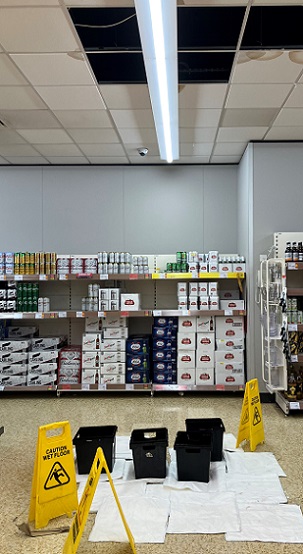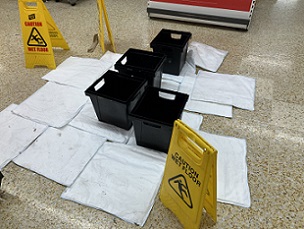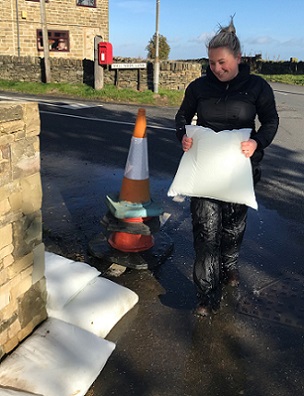 Supermarkets are vulnerable to flooding through their roofs leading to health and safety problems for staff and customers
Supermarkets are vulnerable to flooding through their roofs leading to health and safety problems for staff and customers
 FloodSax in their dry state soaking up water in a supermarket
FloodSax in their dry state soaking up water in a supermarket
 Lucy Bailey from FloodSax deploying a FloodSax as an alternative sandbag
Lucy Bailey from FloodSax deploying a FloodSax as an alternative sandbag
Why supermarkets are so vulnerable to flooding and many are turning to FloodSax alternative sandbags to help them deal with floods both indoors and out
Flash floods have been sweeping across the country and alternative sandbag company FloodSax has seen a sudden upsurge in demand from supermarkets struggling to cope with flooding.
The versatile FloodSax is now widely used by one of the ‘big five’ supermarkets to help it to deal with flooding both inside and out.
Many supermarkets have flat roofs which makes them vulnerable to water getting in, especially during torrential downpours, while others have car parks on inclines which means water from flash floods flows straight across the tarmac and into the store.
FloodSax are vacuum-packed so are space-saving to store but can be transformed into instant sandbags in minutes to keep floodwater out of the premises, potentially saving hundreds of thousands of pounds in damage and lost stock.
In their dry state they are ideal to soak up drips, leaks, spills and floods inside.
They are ultra-thin with a large surface area so can be slipped under refrigeration units and other hard-to-reach places to soak up water.
The danger is the water could not only damage the units and their electrics, but water leaking across the floor is a health and safety risk which could see customers and staff slipping and hurting themselves.
FloodSax are manufactured by Environmental Defence Systems based in Huddersfield, West Yorkshire, and almost 3 million have been sold worldwide.
Lucy Bailey from FloodSax said: “We’ve had emergency requests for help over the last couple of days from supermarkets in areas of the UK hit hard by flash flooding.
“A common factor for some supermarkets is the roofs and the fact they are flat and so more vulnerable to water getting in and some simply can’t cope with the sheer volume that comes down in a flash flood.
“There has been a video on the internet in the last week showing a ceiling collapsing inside a supermarket after water poured in.
“It’s vital that supermarkets and all buildings that require facilities management have flood alleviation products in place to deal with floods both inside and out as every second really does count when it comes to water damage. Each minute the flood expands can cause damage running into thousands of pounds.”
Many businesses don’t realise that local authorities have no responsibility to provide sandbags.
The Environment Agency states: “Don’t assume the authorities will provide you with sandbags in a flood emergency. It is the responsibility of property owners to take appropriate action to protect their property from flooding. Sandbags are relatively ineffective when compared to purpose-built flood protection products. We strongly encourage people to use these products.”
Some councils now recommend FloodSax instead of traditional sandbags.
Gosport Borough Council in Hampshire says: “FloodSax have many advantages over traditional sandbags being easy to store and move, easy to use and, importantly, easy on the environment, having a significantly lower carbon footprint.”
FloodSax are vacuum-packed in packs of five in easy to carry bags and four packs fit into one cardboard box weighing just 21lbs (9.5kilos)– that’s the equivalent to 20 traditional sandbags.
To deploy FloodSax as alternative sandbags when a flood is forecast or is actually happening, simply immerse the FloodSax in 20 litres of water in a large bucket or tub. If time is really critical use the floodwater itself.
The FloodSax will then expand in around 5 minutes to weigh 20kg (44lbs). A special gelling polymer inside simply absorbs the water and then keeps it in the FloodSax so it can be used for however long the emergency lasts, which could be several months.
Each row of FloodSax will keep out approximately 7 inches of water and usually two or three rows are enough to keep floodwater at bay.
To find out how to get hold of FloodSax go to http://www.floodsax.co.uk/buy/uk-suppliers/